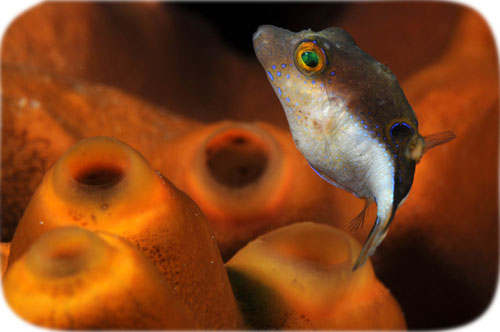Boston.com’s The Big Picture featured an awesome National Geographic photo of some scientists doing Extreme Shallow Snorkeling in a Tennessee creek in search of a 2-inch catfish. Bonus points: the fish is called the smoky madtom.
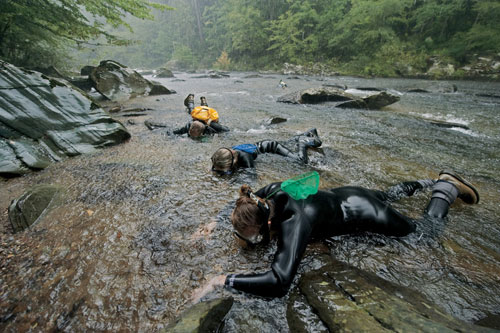
Boston.com’s The Big Picture featured an awesome National Geographic photo of some scientists doing Extreme Shallow Snorkeling in a Tennessee creek in search of a 2-inch catfish. Bonus points: the fish is called the smoky madtom.

Boston.com’s The Big Picture is a generally fantastic photo blog, and today today they posted some really striking photos of oil-soaked sea birds.
I think it is interesting that, as far as oil spills are concerned, birds really seem to capture human emotion more than almost anything else. I think partially it is because birds are relatively intelligent and vocal and we can recognize their suffering. Part of it is probably that they are perhaps more visible than many of the creatures that are undoubtedly dying out in the ocean.
I think it also comes from the impact of seeing these sleek, soaring animals grounded and stuck in sludge. They’re essentially the tribe of dinosaurs that took to the skies, and in these photos, they’re transformed into gruesome apparitions stuck in ancient muck.
Since we arrived in November, the bridge in Grand Case has spanned a stretch of sand rather than a canal to the salt pond that surrounds the airport. As we prepare for the coming hurricane season, however, that is changing. A couple days ago a digger began excavating the sand to create a canal leading out to the bay in preparation for potential rains that may fill the salt pond and require an outlet.
Although it is probably necessary, it is also disturbing because it will inevitably release the very dirty pond water into the bay, polluting the water and the beach. Without knowing for sure, I would guess that the pond is not only a dumping ground for visible trash, but also contains sewage from nearby homes and businesses. Although there are mangroves surrounding the pond and plants and animals absorbing and filtering some of the pollution, it’s clearly not nearly enough to handle the amount of waste that accumulates there. It will be interesting to see the impact on the bay and the pond when the canal is fully open.
I took advantage of the calm weather and clear water and did a bit of snorkeling in the bay. A bit offshore, where the turtlegrass meets the sandy bottom, there are rolling patches of unattached seaweed mixed with trash, including lots of snorkeling masks, even more plastic cups and bags and a few young fish and other critters hiding amongst the flotsam. I also found a crab pot with a bunch of crabs and one cowfish that did not seem pleased with the situation.
Here’s a pretty awesome video of coral gardening which include some time lapse shots of coral as it grows. I saw this on the blog Deep-Sea News, which I highly recommend for their “salty blogging.” Also check out our previous post about artificial reefs.
via videosift.com
Giant globs of mucus-like gunk called mucilages are on the rise. Formerly a summer phenomenon in the Mediterranean, rising temperatures have resulted in mucilages forming in winter and lasting for months. They can be up to 124 miles long. Made mostly of dead matter, they can harbor bacteria and viruses and pose a risk to swimmers. For more info, see National Geographic.
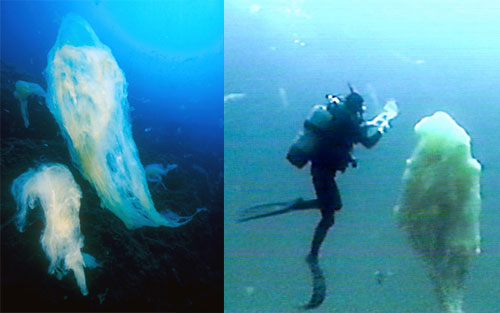
There’s a problem with your Filet-o-Fish. It may be overfished. It turns out that a deep sea fish called the Hoki (Macruronus novaezelandiae) is used for many fast food fish products, including up to 15 million pounds of McDonald’s sandwiches in some years. The Hoki also serves as yet another warning about depleting our fisheries, because it was thought to be a sustainable resource.
The rise of the Hoki as a food fish was partially because the Orange Roughy (picutred below) was found to be a very fragile resource. Thought to live up to 140 years, the Orange Roughy is slow to reproduce and mature. It probably does not take a genius to realize that you should probably avoid eating things that live that long. The Hoki lives only 25 years and was thought to be abundant in the New Zealand waters where it is fished, but without actually acknowledging dwindling stock, the government there has already slashed the quota by two-thirds. It seems that this fishery, which actually won an award for being sustainable and well-managed may have already become overfished only a few years after it really became significant in the 90s. Read more at the New York Times.
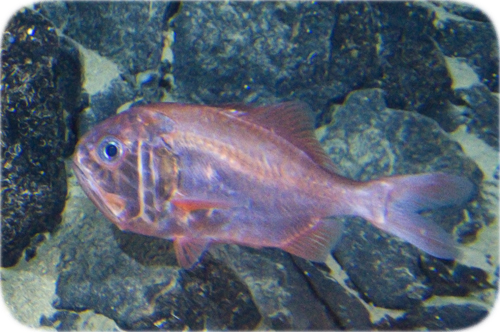
A friend sent me a link to this story about how Damselfish may be destroying Caribbean reefs. In a nutshell, Damselfish farm algae, but their algae gardens kill the coral. Normally this is fine in moderation, but due to overfishing there aren’t enough big fish like groupers to eat the Damselfish. So, the Damselfish and their gardens spread, threatening already-fragile reefs.
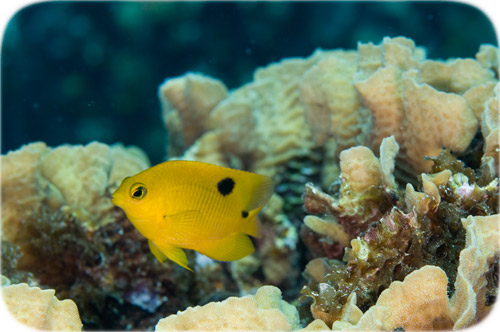
Damselfish guarding the farm in Roatan.
Parrotfish and other creatures eat algae, allowing corals to grow back. Reduced numbers of these algae feeders may also contribute to the spread of algae. And do not underestimate the tiny Damselfish when it is defending its farm! Madam J saw a Damselfish repeatedly dive-bombing the head of a sea turtle who was trying to chow down on the farm. Eventually, I believe it succeeded in pestering the turtle into leaving!
On our recent expedition to Roatan, I was able to take some striking close-ups of coral using a 60mm macro lens on my new camera setup. While corals often look like plants, they are actually animals – colonies of individual polyps that together build the structures we think of as coral. Viewed very close up gives one a strikingly different take on the look of coral. Here you can see the polyps extended:
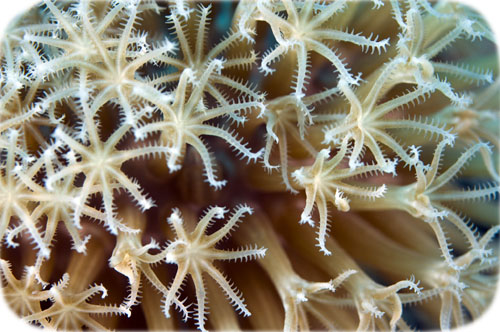
Here you can see how different a coral looks when the polyps are retracted, giving the coral a knobby look:
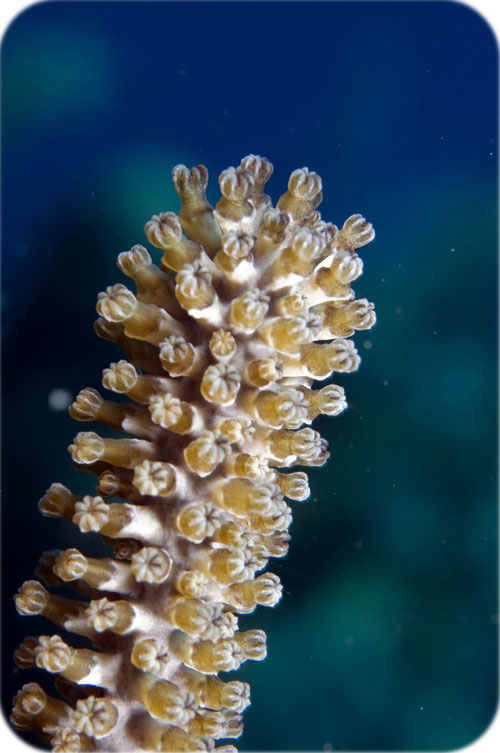
One of our favorite friends, the Sharpnose Puffer (Canthigaster cinctus), was amazingly common on our January trip to Roatan, and much less so during our May expedition. Hopefully it was a seasonal, and not a permanent change. It was also disturbing to notice that many of the remaining Puffers in May were covered in warts and some had missing fins. Anyhow, as you can see, they are adorable little fish!
